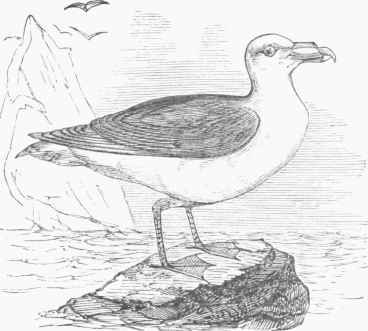Fulmar
Description
This section is from "The American Cyclopaedia", by George Ripley And Charles A. Dana. Also available from Amazon: The New American Cyclopędia. 16 volumes complete..
Fulmar
Fulmar, a species of large petrel of the genus procellaria (Linn.) or fulmarus (Leach). This bird (P. glacialis, Linn.) is about 20 in. long, with an alar extent of 3 ft. and a weight of 1 1/4 lb.; the bill, iris, and feet are yellow, the latter with a greenish tinge; the head, neck, and lower parts pure white; back and wings light grayish blue, palest on rump, and the tail bluish white; quills and their coverts blackish brown; a black spot before and partly over the eyes. It is abundant in the arctic seas, where it attends the whale ships, seizing the pieces of blubber which fall into the water, and often boldly helping itself from the carcass while the men are at work. It breeds in the northern regions, coming down on the American coast as far as Long Island in the autumn, winter, and early spring, and is pretty common on the banks of Newfoundland, where it feeds on the garbage rejected by the cod fishers. It also breeds in the island of St. Kilda, on the W. coast of Scotland, where the inhabitants eat the flesh and eggs, preserve the down and feathers, and collect oil by boiling down the young, which is used for burning and tor medicinal purposes.
The eggs are pure white, with very brittle shells, regularly ovate, 2 7/8 by 2 in., and are obtained with great difficulty and danger, as the nests are in the crevices of nearly perpendicular rocks. It is a bold and powerful bird, a rapid and graceful flyer, an excellent swimmer, but awkward on land; it rarely dives; it is hardy, difficult to kill from the thickness of its plumage, and can inflict severe wounds with the bill. Several other large species of petrels are also called fulmar. (See Petrel.)

Fulmar (Procellaria glacialis).
Continue to:


